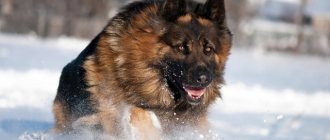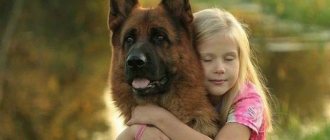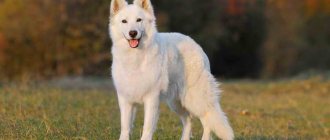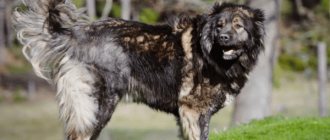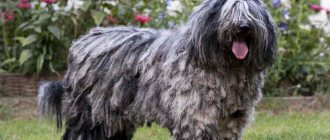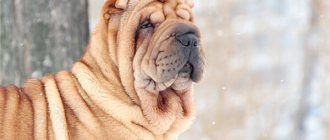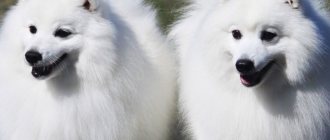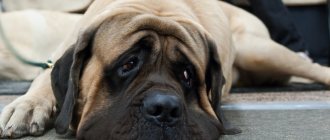Short description
This Germanic dog is considered one of the most intelligent dog breeds in the world. The main meaning of life for such dogs is service to their owner. They become attached to one owner, who must raise and train them. It is worth noting that they also develop attachment to other family members.
Another distinctive feature of such dogs can be considered their fearlessness and courage. If the owner is in danger, the dog will immediately try to protect him.
Additional Information! Many people decide to get long-haired shepherd dogs to guard their apartment or garden.
Color, coat type and length
According to the accepted German Shepherd standard, its coat can be colored in the following colors:
- ginger;
- grey;
- orange;
- black.
Sometimes the coat has darkish inclusions. For example, black dogs with lighter spots are often found, or vice versa. Among dog breeders, dogs with a reddish color are popular. Also common are black dogs that have reddish markings on their faces.
Many novice dog breeders are interested in what kind of coat a shepherd dog can have. The most common are long-haired and short-haired dogs. Moreover, the latter do not tolerate unfavorable weather quite well, as they have a short undercoat.
Additional Information! On the scruff of the neck, representatives of the German breed of dogs have hair that is many times thicker than on other parts of the body.
Postpartum period
After the birth is over, the dog is dried and taken out for a short walk. At this time, it is necessary to change the dirty bedding and lay clean diapers on the floor of the box. The room where the bitch gave birth should be very warm so that the babies do not freeze.
In the first day, the shepherd may develop eclampsia, which is manifested by the following symptoms: unsteady gait and convulsions. In this case, the animal is given Corvalol or Valocordin (25-30 drops), and then an injection of calcium gluconate 10% (up to 5 ml, depending on weight) and magnesium sulfate (4 ml) is given. After providing first aid, you should consult a doctor.
The birth process takes a lot of energy from a dog. During pregnancy, it is necessary to feed the animal fully so that the puppies do not have any pathologies or complications. Before planning mating, you need to contact specialists in order to choose a suitable pair for your pet.
Types of construction: height, weight and dimensions of representatives of the breed
The large body is the main feature of the representatives of the breed.
German Shepherds are considered to be quite large dogs, since their height reaches 65 centimeters. There are cases when a shepherd at the withers grows to 70-75 centimeters.
Despite their rather impressive height, such dogs do not weigh very much. For example, a male dog can weigh about 35 kilograms. At the same time, females with considerable height at the withers have a more refined figure. They weigh no more than 30 kilograms.
Diseases, life expectancy
Thanks to careful selection of individuals for breeding, purebred German Shepherds have good health. Their life expectancy is on average 10–14 years. At the same time, there are diseases characteristic of the breed:
- Hip dysplasia. With this disease, the hip joint develops incorrectly. It appears as the dog matures. Dysplasia can cause lameness and disability. The disease is hereditary, therefore, if present, individuals should be removed from breeding programs. Puppies are tested for a tendency to dysplasia; you can ask the breeders for the results.
Hip dysplasia in dogs is an irreversible pathology requiring surgical intervention.
- Bloating, gastric volvulus. A dangerous pathology that occurs when a dog engages in physical activity after eating. If you suspect this illness (vomiting, lethargy), you need to urgently contact a veterinarian, otherwise the dog faces death within 3-4 hours.
- Hemophilia, a blood clotting disorder. The disease is typical for males; its carriers are females. Identified by genetic tests, carriers are excluded from breeding.
- Degenerative myelopathy. It is similar to multiple sclerosis in humans. It is an incurable disease and is detected only symptomatically (gait disturbances, inappropriate or atypical behavior for a dog).
- Epilepsy is a chronic disease of the nervous system. The attack manifests itself as convulsions, after which the dog may lose consciousness. The pathology cannot be cured, but can be suppressed with medications.
German Shepherd: breed standard according to RKF - FCI
An elongated muzzle is a distinctive feature of shepherds.
Every person who has seriously decided to get a German shepherd should become familiar with the breed's conformation standard.
The RKF-FCI Standard says that the appearance of shepherd dogs has the following distinctive features:
- Ears. They can be considered a distinctive feature of these doggies. They are directed vertically upward. At the same time, they have a rather unusual position, since they stand with their shells facing forward. Dogs' ears may roll back a little when moving.
- Muzzle and head. Representatives of the breed have a wedge-shaped head with a slightly convex forehead. The skull has a rather unusual shape. It tapers slightly near the nose and ears. Shepherds also have a well-developed and wide jaw.
- Neck. The Germans have a very strong neck, with well-developed muscles visible on it. The skin adheres tightly to the muscles and therefore most shepherd dogs lack dewlap.
- Frame. Adults have a well-developed body. The top line runs from the base of the neck to the withers. German dogs also have a well-developed back. Especially in dogs that are older than one year.
- Paws. The front ones are located parallel to each other. At the same time, their elbows are perfectly straight, turning neither out nor inward. The claws are painted black. The pads have a rough surface. Strong and well-developed muscles are noticeable on the thighs.
- Tail. Quite short, rarely reaching the hock joint. The coat on the tail may vary. Most often the hair is slightly longer on the bottom than on the top.
- Nose. Shepherd dogs have a perfectly straight nose with no humps. The lobe is painted black, without inclusions.
Additional Information! The shepherd's eyes are quite large.
Most often they are colored brown.
How to help puppies and dogs during childbirth
Most German Shepherds cope with childbirth on their own without intervention from their owners, but sometimes they need help.
If the attempts last for a very long time, it is necessary to help the puppy to be born. To do this, the baby is carefully taken by the paws or the skin on the neck and pulled out, rocking him in different directions. In case of breech presentation, it is necessary to lubricate the dog’s vagina with Vaseline or oil. The puppy is held by the hind legs and tail and gently pulled out.
If the bitch is weak, she is given some sweet tea with a little milk or weak chicken broth.
If the birth lasts long enough and the dog is very tired and refuses to lick the puppies on his own, it is necessary to clean their nose and mouth. To do this, use a small syringe, and the mouth is washed with a sterile piece of gauze.
The umbilical cord is tied at a distance of 2-3 cm from the tummy and cut off. The baby is thoroughly dried with a towel. If the puppy is breathing heavily, pick it up, fix its head with your fingers and gently but vigorously shake it down. Thanks to these actions, the mucus will be released from the respiratory tract, and the baby will begin to squeal and breathe.
Features of movement
Graceful movement is what distinguishes shepherd dogs from most other breeds.
Representatives of this breed are classified as trotters and therefore they move accordingly. Their limbs are synchronized with each other so that during movement the topline does not move much. While walking, the dog begins to push off with its hind limbs. In this case, the front legs begin to protrude slightly beyond the body.
If the dog has the correct physique, its body will begin to gradually lean forward while walking. The dog moves gracefully and quite smoothly.
Additional Information! When a German Shepherd sneaks, it slowly begins to lower its head and raise its tail.
Harbingers
You can recognize an imminent birth by the behavior of the shepherd dog. The dog begins to worry and even refuses his favorite food. At this time, the pet's temperature is measured. Normally, it ranges from 38 to 39 degrees, but the day before birth it drops to 36-37.
At this time, they begin to prepare the necessary equipment:
- oilcloth or large absorbent diapers;
- sterile gauze wipes or wide bandage;
- towels;
- clean tool tray;
- sharp scissors with round tips;
- strong sterile threads;
- brilliant green or iodine;
- syringes;
- oxytocin;
- cotton wool;
- disinfectant solution (furacilin, chlorhexidine, etc.).
Be sure to have the number of a veterinarian at hand, who must be called if something goes wrong during the birth process.
First prepare a notebook or a blank notebook in which you draw a plate with the following column names: time of birth, weight, gender. After each puppy is born, data is entered into this table.
Childbirth takes place in two stages:
- Preparatory. Duration – from 6 to 30 hours. At this time, contractions begin and the cervix dilates.
- Fetal release . The cervix is fully dilated. Periodic attempts occur, during which the puppy enters the birth canal. Babies move outwards with their heads or tails first. During their passage through the birth canal, the fetal bladder ruptures. After the puppy is born, the mother gnaws the umbilical cord and begins to actively lick the baby's face, freeing his mouth and nose from mucus.
After the birth of each puppy, an afterbirth must be released; its release is accompanied by green and bloody discharge. You can let the bitch eat 1-2 pieces, and the rest should be disposed of. If the placenta does not come out within an hour, the animal is given an injection of oxytocin.
The interval between the birth of babies varies from 2 to 60 minutes. If 2-3 hours have passed since the birth of the last one, and the bitch remains calm and the contractions have stopped, the birth is over.
Disadvantages of the breed
A small apartment is not the best place to keep a shepherd.
Shepherds, like other types of canines, have a number of disadvantages, due to which they are often not accepted to participate in exhibitions. The most well-known disadvantages include:
- High level of activity. Such dogs are quite active and because of this, some dog breeders have difficulties with their further training.
- Requires constant attention. Such pets must be carefully looked after and not left alone. You need to walk them outside for several hours every day. This is why experienced dog breeders do not advise people with a sedentary lifestyle to have shepherd dogs.
- Expensive content. Keeping representatives of the German breed is not always cheap. Often you have to spend money on expensive food. People who cannot cope with training on their own have to spend additional money on paying for the services of a dog handler.
- Not very suitable for keeping in small apartments. It's no secret that shepherds are considered quite large dogs. Therefore, they do not recommend keeping them in small houses or apartments. The dog should have enough free space.
- Difficulty in training. Training shepherds is quite difficult. Especially young ones, up to ten months old. Therefore, many people decide to entrust this matter to experienced dog breeders.
The German Shepherd is a popular dog breed that is adopted by many dog owners. Before you buy such a pet, you need to familiarize yourself with the basic parameters of the breed standard, as well as how much money you will need for maintenance.
Basics of proper care
You need to start caring for your dog from your first day together. You should immediately prohibit doing something that, in your opinion, is not advisable to do. For example, lie down on a bed or sofa. It is necessary to isolate from the animal all things that it can chew. Remove the wires, close the doors to those rooms into which your baby should not poke his curious nose. Caring for a pet includes not only continuous attention, but also compliance with certain conditions for its normal existence in each year of its life.
Caring for and maintaining your pet includes the following basic points:
- habitat;
- walks;
- hygiene.
Content area
The most suitable place for a dog like a German Shepherd to live is undoubtedly a street where the baby can have plenty of fun in the fresh air. A private house is best suited for this purpose. For comfort, it is worth building a strong enclosure with a wooden floor, a roof and a comfortable booth. All this will reliably protect the German from climatic conditions. If you live in an apartment, then, naturally, you can take excellent care of your pet there, too, by creating a wonderful place.
It should not be located in a passage where a draft is possible, near doors and heating appliances. The dog should not sleep in the bathroom or kitchen either. Having chosen a decent corner, you need to lay a special rug or mattress there, which, ideally, is best covered with a pillowcase. This is very convenient for keeping the sleeping area clean. Prepare several pillowcases so you can change and wash them on time.
Prepare for the fact that at first your beloved baby will do his dirty deeds at home, because he still can’t stand it. Gradually, it is necessary to teach him to relieve himself while walking, immediately after feeding or sleeping. Always reward your dog with a tasty bite of his favorite treat as soon as he does the wet thing. Thanks to your efforts, by six months the shepherd will learn to relieve itself only in the yard.
During the first days, the puppy may whine loudly, missing his mother and his former home. Therefore, you should not leave him in a dark enclosed area or tie him up. Try to calm him down with gentle words, give him a toy. But it will be unnecessary to constantly stroke or squeeze the baby: this risks instilling unnecessary qualities.
Going outside
The Shepherd simply needs stable long walks. You can start walking your pet only after all vaccinations have been completed. As mentioned above, the best option for a dog is to live on the street, where there is a constant opportunity to run freely in the open air. If this option is not available and you live in an apartment, then you need to take your pet for a walk every day, gradually increasing the walking time. It's best to take walks during the daytime to take advantage of the sun's natural ultraviolet rays.
The first walks should be short, five minutes will be enough. At the age of two months, hikes increase to half an hour, while at 6–10 months it is necessary to spend two to three hours walking. From two months you can accustom your dog to a leash. While the baby is small, physical activity is contraindicated for him; as he runs around, it will immediately become clear that it is time to go home. When your pet gets older, it will be very good for psychological development if he interacts with other purebred dogs in specially designated areas. But you shouldn’t let stray dogs near them - the risk of disease is high.
Now let's look at German Shepherd hygiene.
Animal hygiene
The eyes are clean, without discharge, with a clear gaze. You need to worry when your dog experiences inflammation or redness, or unnatural watery eyes; if he blinks frequently. If these symptoms occur, you should immediately contact your veterinarian or use special eye drops. You can also soak a cotton swab in chamomile infusion and rinse your eyes with it.
Teeth should be brushed once every three months with a special tooth powder. In pet stores you can also purchase special fluoride-based bones. Also suitable for this purpose are artificial bones made of leather, which will cope with cleaning fangs and massage your pet’s jaw.
Ears are cleaned once a month. This can be done either with a tampon or with special-purpose means. Be careful when observing your baby's ears. They contain a small amount of odorless sulfur. If redness, wet discharge are visible, a bad odor is felt; A pet scratches its ear and shakes its head, which means inflammation is occurring. Don't hesitate and consult a doctor.
The coat should be combed once a week with a special comb. We recommend washing your dog three times a year, except in winter, using specialized dog hygiene products. After each walk, wash your pet with plain water; if there is no special contamination, wash only the paws. After the bath, dry the animal's fur thoroughly. After a bath, try to protect your dog from drafts.
Healthy claws do not peel, do not crumble, and are dark in color. If the baby has not sharpened them himself, then they need to be trimmed with special guillotine scissors.
Now let’s take a closer look at what to feed a purebred German Shepherd puppy.

